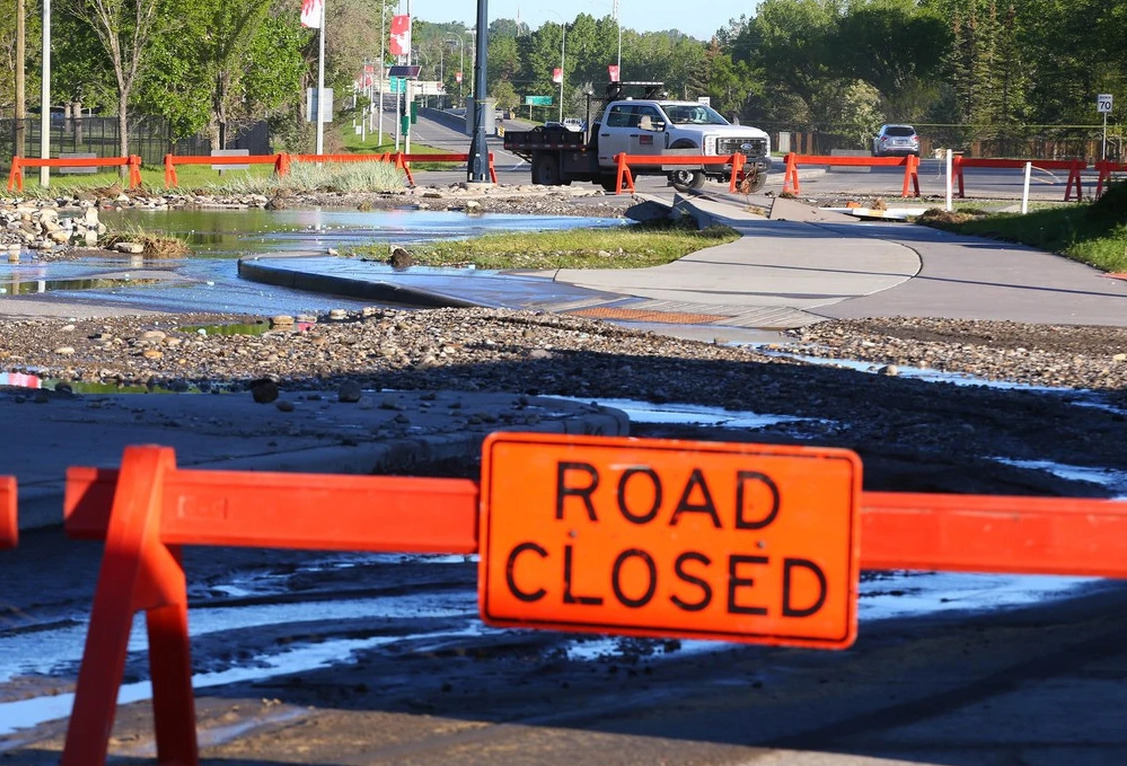
Calgary community faces water restrictions in wake of broken feeder main in Montgomery
By Kimberly Taylor, June 7 2024—
As of June 6, Calgary is under level four water restrictions –- no outdoor water use and reduced indoor water usage—due to the catastrophic failure of the Bearspaw reservoir feeder line on Wednesday June 5 evening at approximately 7 p.m. During level four water restrictions, the fine for infractions is $3,000. Additionally, the city has also implemented a fire ban to prevent the need to draw water to fight fires. The city is asking people to use 25 percent less water than they usually do.
In an interview with the Gauntlet —Canada Research Chair in hydrologic modelling and a professor with the Schulich School of Engineering and Faculty of Arts (Geography) — Dr. Tricia Stadnyk explained what the restrictions mean for Calgary residents.
“It works out to approximately a reduction of 90 liters per person per day. That’s one bath per day, five to 10 minute shower with a low flow showerhead, several flushes of a toilet, one load of wash, or one load of dishes. If you’re not doing that per person in your house, if you have four people in your house you have to do four of those things. [Only] then you’re reducing by the amount we need to in order to make sure there’s enough water in the system [so] that when everyone turns on their taps you still have water coming out of it.”
The damaged feeder is connected to the Bearspaw reservoir and treatment plant – which provides sixty percent of the city’s water. Stadnyk explained that since the damage was to a large pipe at the top of the network the effects have been widespread.
“The reason why this is so significant is because it is a feeder, it is the largest diameter, it carries more water volume, but it’s also the location in this particular case. This feeder happened to be at the top of the piping network.”
“It really affects everybody in the entire downstream system, it happens to feed a sizable portion of the city, over a million people and a lot of different neighbourhoods spanning from the northwest to the northeast to the southwest to the southeast.”
Stadnyk also stated the reason for these restrictions is to maintain pressure across the entire water system. The break in the feeder line results in a decrease of pressure, which will lead to a lack of water supply in homes across Calgary.
“The more water we use the quicker those levels come down, and the quicker the pressure in the whole system reduces. If you don’t reduce by this amount, then eventually those levels aren’t going to be sufficient to get water to your house. You’re going to turn on your tap and there’s not going to be any water.”
Stadnyk explained this is being called a catastrophic break for several reasons, the difficulty in finding the exact location and cause, the difficulty of repair and the damage caused.
“These kinds of breaks are described as catastrophic for a reason. Number one they’re extremely difficult to find the cause and the specific location that the break happened.”
Additionally, Stadnyk stated that accessing and repairing the feeder line is difficult due to the size of the pipe and that water continues to flow through it.
“The bigger the main, and the feeder in this case one of the largest in the city, the more material you have to dig away around it in order to get at it to fix it,” Stadnyk said. “There’s lots of mud, there’s lots of dirty water [and] it’s not easy to get in there and actually see what’s happening.”
These difficulties and damage mean that a full repair will take some time.
“I don’t think we’ll have to deal with water shortages during the entire repair, but it’s not going to be a matter of a day or two,” said Stadnyk.
Stadnyk was also able to discuss the cause of the catastrophic failure, stating that since the pipe is older it has reached the end of its service life.
“For a pipe like this, it’s towards the end of its service life, which means the chance of having a failure is much much higher. The majority of pipes like this fail when they are fifty years old or thereabouts, so this is in a way statistically expected.”
Stadnyk highlighted that infrastructure maintenance is expensive and disruptive, but that repairs after catastrophic failures are even more so.
“We’re talking about tens of millions of dollars to dig up a pipe like this and replace it. It’s not an easy thing to do. Unfortunately the catastrophic failure shows us it’s also a very expensive thing to risk. Because now we’re going to have hundreds of millions of dollars for clean up needs.”
For more updates visit the City of Calgary’s newsroom.
